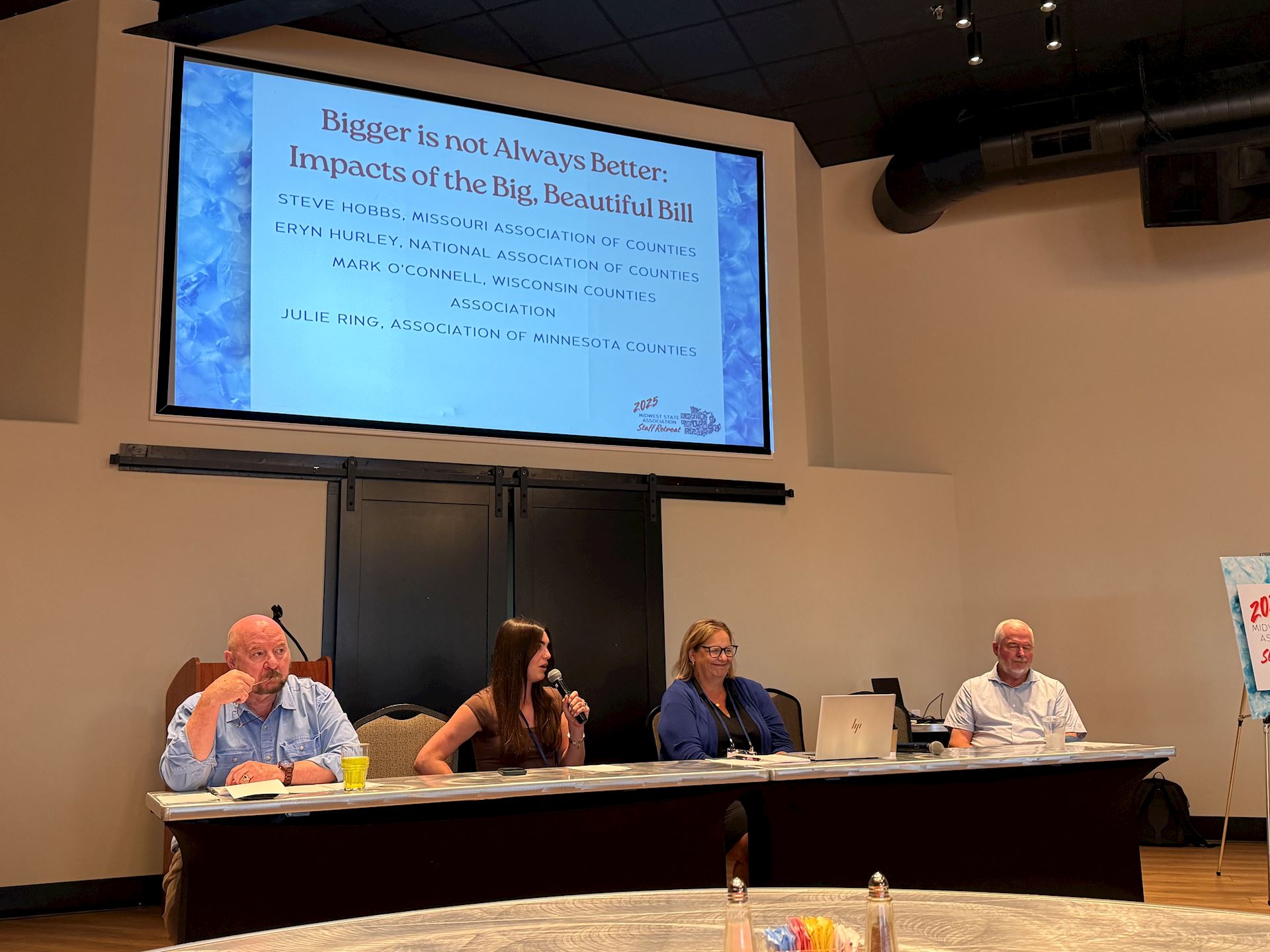During the July 31 Midwest County Association Staff Retreat, ISACo staff and other participants received a detailed briefing on the newly passed federal reconciliation package and its wide-ranging implications for counties. The presentation, led by Eryn Hurley, Managing Director of the National Association of Counties (NACo) Government Affairs Program, outlined the legislation’s fiscal impact, highlighted key policy provisions, and emphasized the need for coordinated advocacy as counties prepare for a shift in responsibilities.
Major Funding Cuts to SNAP and Medicaid
The most consequential provisions of the reconciliation package include substantial cuts to Medicaid—totaling $1 trillion over 10 years—and $190 billion in reductions to the Supplemental Nutrition Assistance Program (SNAP). These changes are expected to remove approximately 10 million people from Medicaid and shift significant administrative and financial burdens onto counties, particularly in states where counties administer SNAP.
Notably, the federal cost-share for SNAP administration in ten county-administered states will shift from 50/50 to 25/75, resulting in an estimated $150 million in new county costs annually by FY2027. Medicaid changes include new work and recertification requirements, a reduction in provider tax caps, and a projected $155 billion funding loss for rural areas. While a $50 billion rural transformation grant program was included, it is unlikely to fully offset the gap, leaving rural hospitals and long-term care providers vulnerable.

In Illinois, both Medicaid and SNAP (Supplemental Nutrition Assistance Program) are state‑administered programs, operating under federal standards.
Medicaid in Illinois is administered by the Illinois Department of Healthcare and Family Services (HFS), which acts as the single state Medicaid agency. HFS designs and oversees the state Medicaid plan, manages eligibility, benefits, provider payments, and coordinates with local public health departments and other state entities.
SNAP, while federally funded and managed by the U.S. Department of Agriculture’s Food and Nutrition Service (FNS), is implemented in Illinois by the Illinois Department of Human Services (IDHS). IDHS is responsible for benefit issuance, eligibility determinations, and local administration through its regional Family Community Resource Centers.
Of note, to avoid a cost shift for SNAP benefits under the new federal reconciliation law, a state’s payment error rate must remain below 6 percent.
Here’s how the cost-sharing tiers work based on error rates:
- Error rate under 6 percent: No state match required (i.e., the federal government continues to cover 100 percent of SNAP benefits).
- Error rate between 6 percent and 10 percent: State required to cover 5% to 15% of SNAP benefits, increasing proportionally with the error rate.
- Error rate above 10 percent: State must cover the maximum 25 percent of benefits.
In fiscal year 2024, Illinois recorded a SNAP payment error rate of 11.56 percent, meaning that overpayments and underpayments combined amounted to that percentage of benefits issued. That rate was higher than the national average of 10.93 percent for FY 2024.
With the new reconciliation legislation now enacted, that elevated error rate places Illinois in the highest cost-sharing tier for SNAP benefits: beginning in fiscal year 2028, the state would be required to contribute 25 percent of SNAP benefits as a state match due to its error rate exceeding 10 percent. This shift drastically increases Illinois’s financial exposure, potentially costing the state hundreds of millions annually unless error rates are significantly reduced.
Wins for Counties
Despite the fiscal challenges, the reconciliation package preserved several key county priorities. Tax-exempt municipal bonds—long under threat—were spared, safeguarding a critical financing tool for local infrastructure. The state and local tax (SALT) deduction cap was also raised from $10,000 to $40,000 for high-income earners.
Additional wins included enhancements to the child tax credit and low-income housing tax credit, providing new tools for addressing housing affordability. Importantly, a provision that would have penalized counties for passing AI-related regulations by withholding broadband funding was removed from the final bill, protecting local control.
Advocacy Imperative
Attendees at the Retreat discussed the political strategies behind several provisions, including the inclusion of state error rates as a determinant for SNAP funding liability. These complex mechanisms not only raise operational concerns but also demonstrate how fiscal responsibility is increasingly being shifted to state and local governments.
With counties likely to see increased property tax pressure to fill federal funding gaps, NACo and its partners emphasized the importance of clear, data-driven messaging about this potential impact. Counties are encouraged to proactively communicate how federal changes may impact local services, staffing, and tax burdens.
The Retreat highlighted the successful advocacy that led to implementation delays and the removal of harmful provisions. Still, further efforts will be necessary to secure additional relief, particularly around Medicaid work requirements, recertification rules, and uncompensated care.
Looking Ahead
Counties were urged to monitor guidance from the Centers for Medicare & Medicaid Services (CMS) on upcoming grant programs and to stay engaged in federal discussions. Future reconciliation packages are likely to resurface debates over municipal bonds and other key issues. Participants were reminded that strategic engagement with congressional delegations and continued alignment with NACo will be essential.
The briefing concluded with a call for vigilance, collaboration, and consistent messaging as counties brace for reduced federal support and greater demands on local resources.